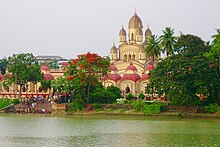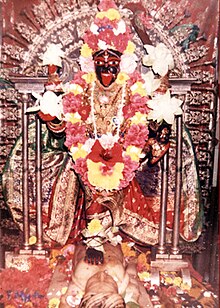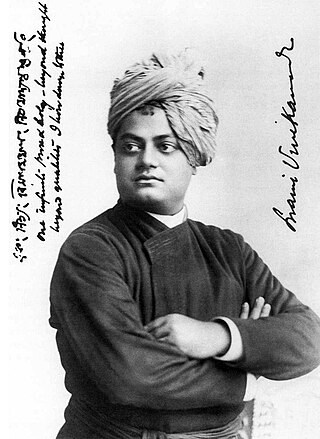
Swami Vivekananda, born Narendranath Datta, was an Indian Hindu monk, philosopher, author, religious teacher, and the chief disciple of the Indian mystic Ramakrishna. He was a key figure in the introduction of Vedanta and Yoga to the Western world, and the father of modern Indian nationalism who is credited with raising interfaith awareness and bringing Hinduism to the status of a major world religion.

Ramakrishna, also called Ramakrishna Paramahansa, born RamakrishnaChattopadhay, was an Indian Hindu mystic. He was a devotee of the goddess Kali, but adhered to various religious practices from the Hindu traditions of Vaishnavism, Tantric Shaktism, and Advaita Vedanta, as well as from Islam and Christianity. He advocated the essential unity of religions and proclaimed that world religions are "so many paths to reach one and the same goal". His parable-based teachings espoused the ultimate unity of diverse religions as being means to enable the realization of the same God. He is regarded by his followers as an avatar.

Sri Sarada Devi, born Kshemankari / Thakurmani / Saradamani Mukhopadhyay, was the wife and spiritual consort of Ramakrishna Paramahamsa, a nineteenth-century Hindu mystic. Sarada Devi is also reverentially addressed as the Holy Mother by the followers of the Sri Ramakrishna monastic order. The Sri Sarada Math and Ramakrishna Sarada Mission situated at Dakshineshwar is based on the ideals and life of Sarada Devi. She played an important role in the growth of the Ramakrishna Movement.

Dakshineswar Kali Temple or Dakshineswar Kalibari is a Hindu navaratna temple in Dakshineswar, Kolkata, West Bengal, India. Situated on the eastern bank of the Hooghly River, the presiding deity of the temple is Bhavatarini (Kali), a form of Mahadevi or Parashakti Adya Kali, otherwise known as Adishakti Kalika. The temple was built in 1855 by Rani Rashmoni, a Zamindar, philanthropist and a devotee of Kali Maa. The temple is known for its association with Ramakrishna and Ma Sarada Devi, mystics of 19th century Bengal.
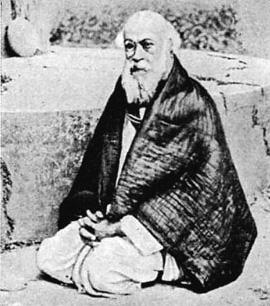
Mahendranath Gupta, , was a disciple of Ramakrishna and a great mystic himself. He was the author of Sri Sri Ramakrishna Kathamrita, a Bengali classic; in English, it is known as The Gospel of Sri Ramakrishna. He was also an early teacher to Paramahansa Yogananda, a famous 20th-century yogi, guru and philosopher. In his autobiography, Yogananda noted that Gupta ran a small boys' high school in Kolkata, and he recounted their visits, as they often traveled to the Dakshineshwar Kali Temple together. Having a devotional nature, Gupta worshipped the Divine Mother in the form of Kali, and often reflected the wisdom of his guru Ramakrishna in his daily life and mannerisms. Yogananda reverentially regarded Gupta's spirituality, calling him an "Incarnation of purity" and "the greatest man of humility I ever knew."Paul Brunton also narratives a meeting with Mahendra, in his famous memoir, 'A search in secret India'.
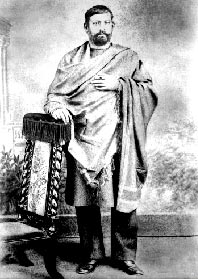
Surendra Nath Mitra aka Surendranath Mitra was one of the prominent devotees of Sri Ramakrishna Paramahamsa. He came from a very prosperous background and had the fortune of sponsoring the expenditures of the Master and his devotees when the Master lived in Calcutta in his last days. He was also known as Suresh Chandra Mitra, but Sri Ramakrishna called him "Surendra". Suresh lived in Simulia Street, the same locality as Narendranath.
Ramakrishna (1836–1886) is a famous mystic of nineteenth-century India. Ramakrishna never wrote down the details of his own life. Sources for his life and teachings come from the writings of his disciples and live witnesses. Ramakrishna's recorded sayings mainly come from the last four years of his life.

Adbhutananda, born Rakhturam, was a direct monastic disciple of Ramakrishna, a Yogi of nineteenth century Bengal. He is familiarly known as Latu Maharaj among the followers of Ramakrishna. Adbhutananda was the first monastic disciple to come to Ramakrishna. While most of Ramakrishna's direct disciples came from the Bengali intelligentsia, Adbhutananda's lack of formal education made him unique amongst them. He was a servant boy of a devotee of Ramakrishna, and he later became his monastic disciple. Though unlettered, Adbhutananda was considered as a monk with great spiritual insight by Ramakrishna's followers, and Vivekananda regarded him as "the greatest miracle of Ramakrishna".

Swami Vivekananda is a 1998 Indian biographical film directed by G. V. Iyer and produced by T. Subbarami Reddy. It took Iyer 11 years to finish the research work required for the film and to write the screenplay.

Ramakrishna Mission Vidyapith, Deoghar is a residential boys' senior secondary school in Deoghar, Jharkhand, India, established in 1922. It is the oldest institute of Ramakrishna Mission, and used to be visited by brother disciples of Swami Vivekananda. Swami Jayantananda is the present secretary, and Swami Divyasudhananda is the current principal of the school.
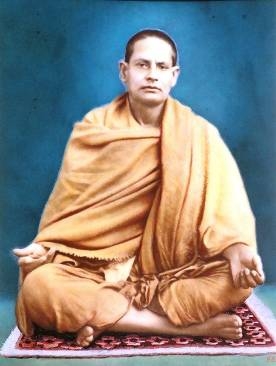
Baburam Maharaj (Swami Premananda) (Bengali: বাবুরাম মহারাজ; 10 December 1861 – 30 July 1918) was a direct disciple of Ramakrishna, the 19th-century saint and mystic from Bengal, India. He was born in Antpur in the Hoogly district of Bengal in the year 1861. Baburam, as he was called in his pre monastic days, was also related to Balaram Bose, a leading householder disciple of Ramakrishna. He was given the name of Premananda or "joy of divine love" by his brother disciple Vivekananda. He had a notable contribution during the initial days of Ramakrishna Mission as he managed the whole affairs of Belur Math from 1902 to 1916. He also mentored young spiritual aspirants.
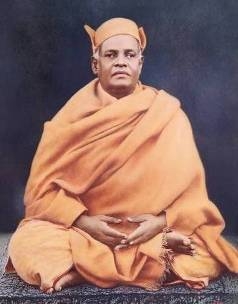
Saradananda, also known as Swami Saradananda, was born as Sarat Chandra Chakravarty in 1865, and was one of the direct monastic disciples of Ramakrishna. He was the first Secretary of the Ramakrishna Math and Ramakrishna Mission, a post which he held until his death in 1927. He established the Udbodhan house in the Bagbazar area of Calcutta, which was built primarily for the stay of Sri Sarada Devi in Calcutta, from where he used to publish the Bengali magazine Udbodhan. There he wrote Sri Sri Ramakrishna Lilaprasanga in Bengali, on the life of Ramakrishna, which was translated into English as Sri Ramakrishna, the Great Master. He is believed to be reincarnation of Saint Peter and he allegedly went into Samadhi when he was in the Saint Peter Church and said that "I remembered my past" and wrote in his diary that "Saint Peter again."

Biley or Bilay is a 2012 Bengali drama created by Bengali theatre group Lokkrishti, This is a dramatisation of the life and works of Swami Vivekananda. Debshankar Haldar played the lead role. Phalguni Chattopadhyay directed this drama and Ujjwal Chattopadhyay was the playwright.

Ram Chandra Datta was a householder disciple of Ramakrishna and a writer. Datta was a relative of Indian monk and social reformer Swami Vivekananda. After completing his graduation, he took job of a Government employee and a chemist. He invented an antidote for blood dysentery from an extract of an indigenous medicinal plant and started promoting "modern science".

Baranagar Math or Ramakrishna Math, Baranagar was the first monastery of Ramakrishna Order. In September 1886, after the death of Ramakrishna, when his devotees stopped funding, Swami Vivekananda and other disciples of Ramakrishna decided to make a dilapidated house at Baranagar their new math. The house crumbled to dust in 1897. In 1973 Vivekananda Math Samrakshan Samity was formed who attempted to preserve the area. In 2001, the possession was handed over to Belur Math authority, who soon-after declared it as one of their official branch. The restoration and development work of the area is still going on.
Meditation played a very important role in the life and teachings of Swami Vivekananda. He was interested in meditation from his childhood. His master Ramakrishna found him a dhyana - siddha . On 24 December 1892, Vivekananda reached Kanyakumari and meditated for three days on a large rock and took the resolution to dedicate his life to serve humanity. The event is known as the Kanyakumari resolve of 1892. He reportedly also meditated for a long time on the day of his death.

The relationship between Ramakrishna and Vivekananda began in November 1881, when they met at the house of Surendra Nath Mitra. Ramakrishna asked Narendranath to sing. Impressed by his singing talent, he invited him to Dakshineswar. Narendra accepted the invitation, and the meeting proved to be a turning point in the life of Narendranath. Initially Narendra did not accept Ramakrishna as his master and found him to be a "mono maniac", but eventually he became one of the closest people in his life. Ramakrishna reportedly shaped the personality of Narendranath and prepared him to dedicate his life to serve humanity. After the death of Ramakrishna, Narendra and his other monastic disciples established their first monastery at Baranagar.

Gopaler Ma was a devotee and a householder disciple of Sri Ramakrishna, the saint and mystic from Bengal. Her birth name was Aghoremani Devi, but she came to be known as Gopaler Ma among the devotees of Sri Ramakrishna, owing to her intense motherly love for Sri Ramakrishna as "Gopala" or baby Krishna. She was famous for her divine visions of Lord Krishna as a baby and her devotion to the ideals of Sri Ramakrishna. In her later years, she was very close to Swami Vivekananda and Sister Nivedita. She spent the last few years of her life with Sister Nivedita.
In 1888, Swami Vivekananda left the monastery as a Parivrâjaka— the Hindu religious life of a wandering monk, "without fixed abode, without ties, independent and strangers wherever they go". His sole possessions were a kamandalu, staff and his two favourite books: the Bhagavad Gita and The Imitation of Christ. Narendra travelled extensively in India for five years, visiting centres of learning and acquainting himself with diverse religious traditions and social patterns. He developed sympathy for the suffering and poverty of the people, and resolved to uplift the nation. Living primarily on bhiksha (alms), Swami Vivekananda travelled on foot and by railway. During his travels he met, and stayed with Indians from all religions and walks of life: scholars, dewans, rajas, Hindus, Muslims, Christians, paraiyars and government officials.
Vishwanath Datta was a Bengali lawyer, philanthropist and novelist. He was the father of Swami Vivekananda, Mahendranath Dutta and Bhupendranath Dutta.
